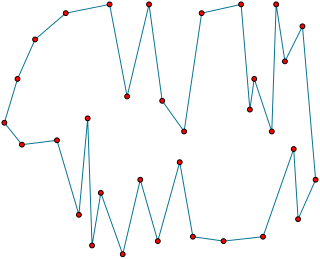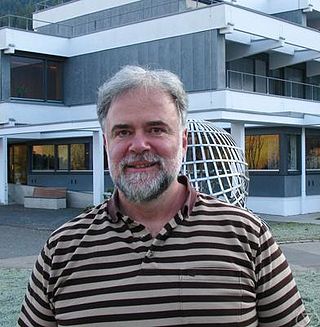
The travelling salesman problem, also known as the travelling salesperson problem (TSP), asks the following question: "Given a list of cities and the distances between each pair of cities, what is the shortest possible route that visits each city exactly once and returns to the origin city?" It is an NP-hard problem in combinatorial optimization, important in theoretical computer science and operations research.
The nearest neighbor algorithm was one of the first algorithms used to solve the travelling salesman problem approximately. In that problem, the salesman starts at a random city and repeatedly visits the nearest city until all have been visited. The algorithm quickly yields a short tour, but usually not the optimal one.

In graph theory, the shortest path problem is the problem of finding a path between two vertices in a graph such that the sum of the weights of its constituent edges is minimized.

A greedy algorithm is any algorithm that follows the problem-solving heuristic of making the locally optimal choice at each stage. In many problems, a greedy strategy does not produce an optimal solution, but a greedy heuristic can yield locally optimal solutions that approximate a globally optimal solution in a reasonable amount of time.

Simulated annealing (SA) is a probabilistic technique for approximating the global optimum of a given function. Specifically, it is a metaheuristic to approximate global optimization in a large search space for an optimization problem. For large numbers of local optima, SA can find the global optima. It is often used when the search space is discrete. For problems where finding an approximate global optimum is more important than finding a precise local optimum in a fixed amount of time, simulated annealing may be preferable to exact algorithms such as gradient descent or branch and bound.

In graph theory, a branch of mathematics and computer science, Guan's route problem, the Chinese postman problem, postman tour or route inspection problem is to find a shortest closed path or circuit that visits every edge of an (connected) undirected graph at least once. When the graph has an Eulerian circuit, that circuit is an optimal solution. Otherwise, the optimization problem is to find the smallest number of graph edges to duplicate so that the resulting multigraph does have an Eulerian circuit. It can be solved in polynomial time, unlike the Travelling Salesman Problem which is NP-hard. It is different from the Travelling Salesman Problem in that the travelling salesman cannot repeat visited nodes.
Tabu search (TS) is a metaheuristic search method employing local search methods used for mathematical optimization. It was created by Fred W. Glover in 1986 and formalized in 1989.
The Bottleneck traveling salesman problem is a problem in discrete or combinatorial optimization. The problem is to find the Hamiltonian cycle in a weighted graph which minimizes the weight of the highest-weight edge of the cycle. It was first formulated by Gilmore & Gomory (1964) with some additional constraints, and in its full generality by Garfinkel & Gilbert (1978).

Combinatorial optimization is a subfield of mathematical optimization that consists of finding an optimal object from a finite set of objects, where the set of feasible solutions is discrete or can be reduced to a discrete set. Typical combinatorial optimization problems are the travelling salesman problem ("TSP"), the minimum spanning tree problem ("MST"), and the knapsack problem. In many such problems, such as the ones previously mentioned, exhaustive search is not tractable, and so specialized algorithms that quickly rule out large parts of the search space or approximation algorithms must be resorted to instead.
In genetic algorithms and evolutionary computation, crossover, also called recombination, is a genetic operator used to combine the genetic information of two parents to generate new offspring. It is one way to stochastically generate new solutions from an existing population, and is analogous to the crossover that happens during sexual reproduction in biology. Solutions can also be generated by cloning an existing solution, which is analogous to asexual reproduction. Newly generated solutions may be mutated before being added to the population.

In computer science and operations research, the ant colony optimization algorithm (ACO) is a probabilistic technique for solving computational problems which can be reduced to finding good paths through graphs. Artificial ants stand for multi-agent methods inspired by the behavior of real ants. The pheromone-based communication of biological ants is often the predominant paradigm used. Combinations of artificial ants and local search algorithms have become a method of choice for numerous optimization tasks involving some sort of graph, e.g., vehicle routing and internet routing.
The Christofides algorithm or Christofides–Serdyukov algorithm is an algorithm for finding approximate solutions to the travelling salesman problem, on instances where the distances form a metric space . It is an approximation algorithm that guarantees that its solutions will be within a factor of 3/2 of the optimal solution length, and is named after Nicos Christofides and Anatoliy I. Serdyukov ; the latter discovered it independently in 1976.
In combinatorial optimization, Lin–Kernighan is one of the best heuristics for solving the symmetric travelling salesman problem. It belongs to the class of local search algorithms, which take a tour as part of the input and attempt to improve it by searching in the neighbourhood of the given tour for one that is shorter, and upon finding one repeats the process from that new one, until encountering a local minimum. As in the case of the related 2-opt and 3-opt algorithms, the relevant measure of "distance" between two tours is the number of edges which are in one but not the other; new tours are built by reassembling pieces of the old tour in a different order, sometimes changing the direction in which a sub-tour is traversed. Lin–Kernighan is adaptive and has no fixed number of edges to replace at a step, but favours small numbers such as 2 or 3.

In computational geometry, a bitonic tour of a set of point sites in the Euclidean plane is a closed polygonal chain that has each site as one of its vertices, such that any vertical line crosses the chain at most twice.
In combinatorial optimization, the set TSP, also known as the generalized TSP, group TSP, One-of-a-Set TSP, Multiple Choice TSP or Covering Salesman Problem, is a generalization of the traveling salesman problem (TSP), whereby it is required to find a shortest tour in a graph which visits all specified subsets of the vertices of a graph. The subsets of vertices must be disjoint, since the case of overlapping subsets can be reduced to the case of disjoint ones. The ordinary TSP is a special case of the set TSP when all subsets to be visited are singletons. Therefore, the set TSP is also NP-hard.
In computational complexity theory, a gap reduction is a reduction to a particular type of decision problem, known as a c-gap problem. Such reductions provide information about the hardness of approximating solutions to optimization problems. In short, a gap problem refers to one wherein the objective is to distinguish between cases where the best solution is above one threshold from cases where the best solution is below another threshold, such that the two thresholds have a gap in between. Gap reductions can be used to demonstrate inapproximability results, as if a problem may be approximated to a better factor than the size of gap, then the approximation algorithm can be used to solve the corresponding gap problem.
The Held–Karp algorithm, also called the Bellman–Held–Karp algorithm, is a dynamic programming algorithm proposed in 1962 independently by Bellman and by Held and Karp to solve the traveling salesman problem (TSP), in which the input is a distance matrix between a set of cities, and the goal is to find a minimum-length tour that visits each city exactly once before returning to the starting point. It finds the exact solution to this problem, and to several related problems including the Hamiltonian cycle problem, in exponential time.

András Sebő is a Hungarian-French mathematician working in the areas of combinatorial optimization and discrete mathematics. Sebő is a French National Centre for Scientific Research (CNRS) Director of Research and the head of the Combinatorial Optimization. group in Laboratory G-SCOP, affiliated with the University of Grenoble and the CNRS.
The Steiner traveling salesman problem is an extension of the traveling salesman problem. Given a list of cities, some of which are required, and the lengths of the roads between them, the goal is to find the shortest possible walk that visits each required city and then returns to the origin city. During a walk, vertices can be visited more than once, and edges may be traversed more than once.

In Pursuit of the Traveling Salesman: Mathematics at the Limits of Computation is a book on the travelling salesman problem, by William J. Cook, published in 2011 by the Princeton University Press, with a paperback reprint in 2014. The Basic Library List Committee of the Mathematical Association of America has suggested its inclusion in undergraduate mathematics libraries.










